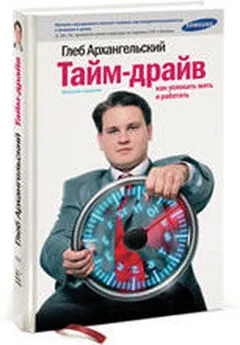Ричард convertfileonline.com - _2016_02_09_21_40_03_404
- Название:_2016_02_09_21_40_03_404
- Автор:
- Жанр:
- Издательство:Манн, Иванов и Фербер
- Год:2016
- ISBN:9785000577332
- Рейтинг:
- Избранное:Добавить в избранное
-
Отзывы:
-
Ваша оценка:
Ричард convertfileonline.com - _2016_02_09_21_40_03_404 краткое содержание
_2016_02_09_21_40_03_404 - читать онлайн бесплатно полную версию (весь текст целиком)
Интервал:
Закладка:
[21]John Seabrook, Nobrow: The Culture of Marketing, the Marketing of Culture. New York: AlfredKnopf, 2000. Издана на русском языке: Сибрук Дж. Nobrow. Культура маркетинга. Маркетинг культуры. М. : Ад Маргинем, 2013)ю
[22]О клубе Homebrew можно прочитать здесь: Paul Freiberger and Michael Swaine, Fire in the Valley: The Making of the Personal Computer. Berkeley: Osborne/McGraw Hill, 1984 (издана на русском языке: Фрейбергер П., Свейн М. Пожар в Долине: история создания персональных компьютеров. М. : Группа Дарнэл, 2000). См. также: John Markoff, “A Strange Brew’s Buzz Lingers in Silicon Valley,” New York Times,March 26, 2000.
[23]Личное интервью автора и Мартина Кенни, март 1987 года.
[24]См. Kevin Gray, “Paul Allen: Revenge of the Nerd,” Details (October 2000): 256—263; Sam Howe Verhovek, “He’s Turning Seattle into His Kind of Town,” New York Times (online version), May 17, 2000; Neil Strauss, “Making a Museum out of Music,”New York Times, June 26, 2000.
[25]Из песни Джими Хендрикса «If 6 Was 9» («Если шестерка станет девяткой»), 1967 год.
[26]См. Harvey Blume, “Geek Studies,” Atlantic Unbound, July 13, 2000; Two Geeks on Their Way to Byzantium: An Interview with Richard Powers,” Atlantic Unbound, June 28, 2000; Scott Stossel, “Soul of the New Economy,” Atlantic Unbound, June 8, 2000. В интернете: www.theatlantic.com.
[27]Jon Katz, Geeks: How Two Lost Boys Rode the Internet out of Idaho. NewYork: Villard, 2000.
[28]Визит и личное интервью автора, осень 2001 года.
Глава 10
[1]С учетом различий в стоимости жизни средняя заработная плата IT-специалистов в Остине составляла в 2001 году 65 310 долларов, тогда как в Сан-Франциско — 47 173 доллара (по данным опроса Information Week о заработной плате).
[2]См.: Thomas Friedman, The World Is Flat. New York: Farrar, StrausandGiroux, 2005 (издана на русском языке: Фридман Т. Плоский мир. Краткая история XXI века. М. : АСТ, 2014). См. также: Edward E. Leamer, “A Flat World, a Level Playing Field, a Small World After All or None of the Above? Рецензия на книгу Thomas L. Friedman, The World Is Flat,” Journal of Economic Literature 45 (1) (2007): 83–126.
[3]Первоначальная статья: Frances Cairncross, “The Death of Distance,” Economist 336 (7934), September 30, 1995. Впоследствии Френсис Кернкросс опубликовала книгу с тем же названием: The DeathofDistance. Boston: Harvard Business School Press, 2001 [first ed., 1997]. См. также статью: “Conquest of Location,” Economist, October 7, 1999.
[4]Richard Florida, “The World Is Spiky,” Atlantic (October 2005); Who’s Your City? How the Creative Economy Is Making Where to Live the Most Important Decision of Your Life. NewYork: BasicBooks, 2008 (издана на русском языке: Флорида Р. Кто твой город? Креативная экономика и выбор места жительства. М. : StrelkaPress, 2014).
[5]“Q&A with Michael Porter,” Business Week, August 21, 2006, www.businessweek.com/magazine/content/06_34/b3998460.htm.
[6]К числу классических работ по этой теме относятся следующие книги: Robert Park, E. Burgess, andR. McKenzie, TheCity. Chicago: University of Chicago Press, 1925; Jane Jacobs, The Death and Life of Great American Cities. New York: Random House, 1961; The Economy of Cities. New York: Random House, 1969 (издана на русском языке: Джейкобс Дж. Экономика городов. М. : Культурное наследие, 2008); CitiesandtheWealthofNations. NewYork: RandomHouse, 1984 (издана на русском языке: Города и богатство наций: Принципы экономической жизни. М. : Культурное наследие, 2009); Wilbur Thompson, A Preface to Urban Economics. Baltimore: The Johns Hopkins University Press, 1965; Edwin Ullman, “Regional Development and the Geography of Concentration,” Papers and Proceedings of the Regional Science Association 4 (1958): 179–198.
[7]Alfred Marshall, Principles of Economics. New York: Cosimo Classics, 2006 [originaled 1890] (издана на русском языке: Маршалл А. Принципы экономической науки. М. : Генеральный директор, 2010).
[8]Существует много работ по теме экономии от агломерации; вот самые последние из них: Maryann Feldman, “Location and Innovation: The New Economic Geography of Innovation, Spillovers, and Agglomeration,” in Gordon Clark, Meric Gertler, and Maryann Feldman, eds., The Oxford Handbook of Economic Geography. New York: Oxford University Press, 2003, pp. 373–394; Adam Jaffe, “Real Effects of Academic Research,” American Economic Review 79 (5) (1989): 957–970; David Audretsch and Maryann Feldman, “R&D Spillovers and the Geography of Innovation and Production,”American Economic Review 86 (3) (1996): 630–640; David Audretsch, “Agglomeration and the Location of Innovative Activity,” Oxford Review of Economic Policy 14 (2) (1998): 18–30.
[9]Adam Smith, The Wealth of Nations. New York: Bantam, 2003 [first ed., 1776]. David Ricardo, Principles of Political Economy and Taxation. New York: Cosimo Classics, 2006 [first ed., 1817] (издана на русском языке: Риккардо Д. Начала политической экономии и налогового обложения. М. : Эксмо, 2007).
[10]Jacobs, The Economy of Cities. New York: Random House, 1969; Cities and the Wealth of Nations. New York: Random House, 1984.
[11]Цит. по: Bill Steigerwald, “City Views: Urban Studies Legend Jane Jacobs on Gentrification, the New Urbanism, and Her Legacy,” Reason (June 2001). Retrieved January 9, 2012 from http://reason.com/archives/2001/06/01/city-views/singlepage.
[12]Robert Lucas Jr., “On the Mechanics of Economic Development” Journal of Monetary Economics 22 (1988): 38–39.
[13]Richard Florida and Scott Jackson, “Sonic City: The Evolving Economic Geography of the Music Industry,” Journal of Planning Education and Research 29 (3) (2010): 310–321; Richard Florida, Charlotta Mellander, and Kevin Stolarick, “From Music Scenes to Music Clusters: The Economic Geography of Music in the U.S., 1970–2000,” Environment and Planning A 42 (4) (2010): 785–804; Richard Florida, Charlotta Mellander, and Kevin Stolarick, “Geographies of Scope: An Empirical Analysis of Entertainment, 1970–2000,”Journal of Economic Geography 1 (2011): 1–22.
[14]Edward Glaeser, Triumph of the City. NewYork: Penguin 2011 (издана на русском языке: Глейзер Э. Триумф города. Как наше величайшее изобретение делает нас богаче, умнее, экологичнее, здоровее и счастливее. М. : Издательство Института Гайдара, 2014).
[15]См.: Robert Barro, “Economic Growth in a Cross Section of Countries,” Quarterly Journal of Economics 106 (2) (1991): 407–443; Determinants of Economic Growth: A Cross-Country Empirical Study. Cambridge: MIT Press, 1997. See Edward Glaeser, “Are Cities Dying?” Journal of Economic Perspectives 12 (1998): 139–160. В последнее время опубликовано много работ о человеческом капитале, в том числе следующие: Glaeser, “The New Economics of Urban and Regional Growth,” in Clark, Gertler, and Feldman, eds., The Oxford Handbook of Economic Geography, pp. 83–98; James E. Rauch, “Productivity Gains from Geographic Concentrations of Human Capital: Evidence from Cities,” Journal of Urban Economics 34 (1993): 380–400; Curtis Simon, “Human Capital and Metropolitan Employment Growth,” Journal of Urban Economics 43 (1998): 223–243; Curtis Simon and Clark Nardinelli, “The Talk of the Town: Human Capital, Information and the Growth of English Cities, 1861–1961,” Explorations in Economic History 33 (3) (1996): 384–413. Всесторонний анализ этой темы можно найти здесь: Vijay K. Mathur, “Human Capital-Based Strategy for Regional Economic Development,” Economic Development Quarterly 13 (3) (1999): 203–216.
[16]Spencer Glendon, “Urban Life Cycles”— неопубликованный рабочий доклад, факультет экономики, Гарвардский университет, ноябрь 1998 года.
[17]Geoffrey West, Luis Bettencourt, Jose Lobo, Dirk Helbing, and Christian Kuehnert, “Growth, Innovation, Scaling and the Pace of Life in Cities,” Proceedings of the National Academy of Sciences 104 (17), April 24, 2007, pp. 7301–7306.
[18]George Zipf, Human Behavior and the Principle of Least Effort. New York: Addison–Wesley, 1949. Впоследствии лауреат Нобелевской премии Герберт Саймон развил первые выводы Ципфа; см.: Herbert Simon, “On a Class of Skew Distribution Functions,”Biometrika 42 (1955): 425–440.
[19]Masahisa Fujita, Paul Krugman, and Anthony J. Venables, The Spatial Economy: Cities, Regions and International Trade. Cambridge: MIT Press, 1999, pp. 216–225.
[20]Robert Axtell and Richard Florida, “Emergent Cities: A Microeconomic Explanation,”Brookings Institution, Washington, DC, April 2001.
[21]Ake Andersson, “Creative People Need Creative Cities,” in David Emanuel Andersson, Ake Emanuel Andersson, and Charlotta Mellander, eds., Handbook of Creative Cities. Cheltenham, UK: Edward Elgar, 2011, pp. 14–55. См. также: Peter Hall, Cities in Civilization. New York: Pantheon, 1998. Charles Landry, The Creative City: A Toolkit for Urban Innovators. London: Earthscan, 2000.
[22]См., например: Peter J. Richerson, Peter J. Boyd, and Robert. L. Bettinger, “Cultural Innovations and Demographic Change,” Human Biology 81 (2–3) (2009): 211–235; Stephen Shennan, “Evolutionary Demography and the Population History of the European Early Neolithic,” Human Biology 81 (2—3) (2009): 339–355; 24.
[23]Robert Park, E. Burgess, and R. McKenzie, The City. Chicago: University of Chicago Press, 1925. Quotes are from p. 40.
[24]Carolyn Ware, Greenwich Village, 1920–1930. Berkeley: University of California Press, 1963 [orig. 1935], pp. 5, 37.
Читать дальшеИнтервал:
Закладка:






